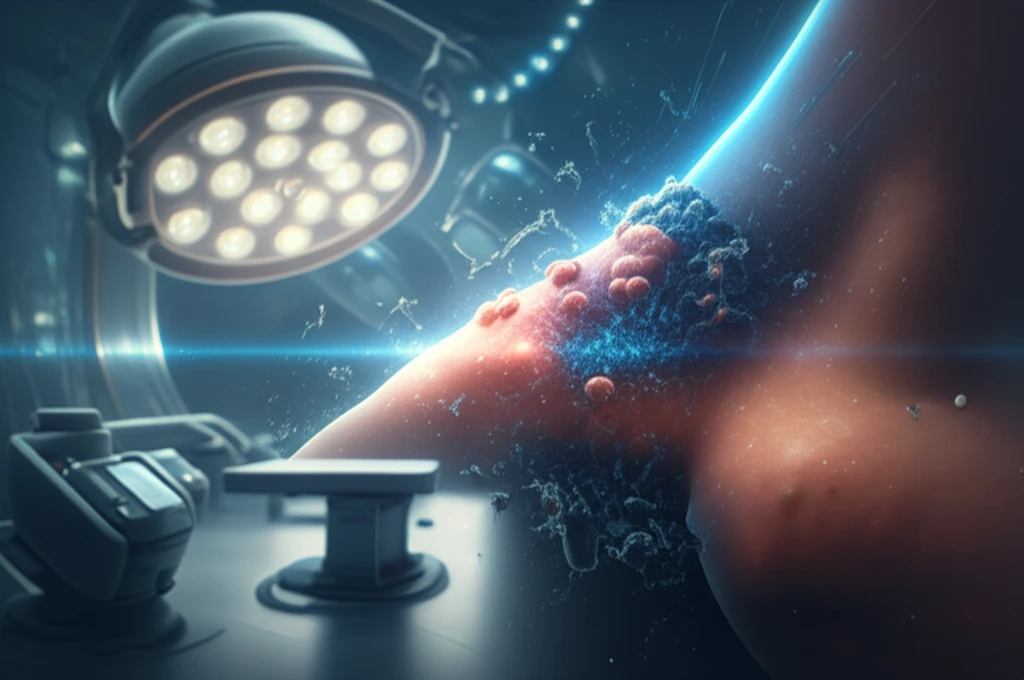
Keloid Breakthrough? How Blue Light Could Change Scar Treatment
"Could a simple blue light device be the future of keloid scar reduction? New research explores the surprising potential of LED therapy."
Keloids, those raised, often itchy scars that form after skin injuries, are more than just a cosmetic concern. For many, they're a source of discomfort, self-consciousness, and a constant reminder of past trauma. Current treatments, ranging from steroid injections to surgery, often come with their own set of drawbacks, including limited effectiveness and potential side effects. This leaves many seeking better, less invasive solutions.
Now, a new avenue of research is offering a glimmer of hope: blue light LED therapy. While the use of light therapy in dermatology isn't new, its application to keloid treatment is just beginning to be explored. Initial studies suggest that specific wavelengths of blue light may influence cellular activity within the scar tissue, potentially leading to scar reduction and improved skin appearance.
This article delves into a fascinating in vitro study investigating the effects of 470 nm blue LED on keloid fibroblasts—the cells responsible for collagen production in scars. We'll break down the science, explore the potential benefits, and discuss what this could mean for the future of keloid treatment. Whether you're personally affected by keloids or simply interested in the latest dermatological advancements, this is a development worth watching.
The Science Behind the Light: How Blue LED Works on Scars

The study, conducted by Brazilian researchers, focused on the in vitro effects of 470 nm blue LED on keloid fibroblasts. Fibroblasts were extracted from keloid tissue and adjacent skin from six patients. These cells were then exposed to varying doses of blue light (6J, 12J, and 18J) and observed for changes in cell count after 24 hours. The goal was to quantify how the blue light affected the proliferation (growth) of keloid fibroblasts compared to normal skin fibroblasts.
- Cell Extraction and Culturing: Fibroblasts were carefully extracted from both keloid and adjacent skin samples and grown in a controlled laboratory environment (DMEM culture medium) to ensure their viability and allow for observation.
- Controlled Light Exposure: The cultured cells were then divided into groups and exposed to specific energy doses of 470nm blue LED light (6J, 12J, 18J) using specialized equipment, while a control group received no light exposure.
- Cellular Analysis: After a 24-hour period, the cells were meticulously counted to determine if the blue light exposure had any impact on the number of keloid fibroblasts compared to the control group and the adjacent skin fibroblasts.
The Future of Scar Treatment: Is Blue Light the Answer?
While this in vitro study provides intriguing insights, it's important to remember that it's just one piece of the puzzle. More research is needed to fully understand the effects of blue light LED therapy on keloids in living organisms. Clinical trials involving human participants are essential to confirm these findings and determine the optimal treatment parameters, including dosage, duration, and frequency. However, the initial results are encouraging, suggesting that blue light LED therapy may offer a safe, non-invasive, and potentially effective approach to keloid scar management. As research continues, we may see blue light becoming an increasingly common tool in the dermatologist's arsenal for improving skin health and reducing the burden of keloid scars.
